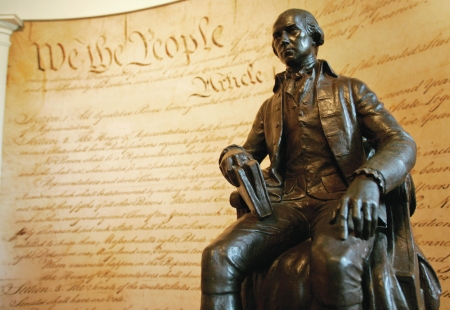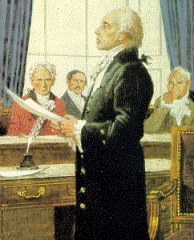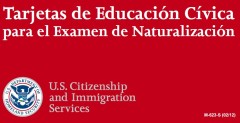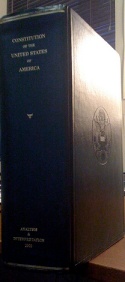 Image: James Madison statue in front of Bill of Rights. AP Photo.
Image: James Madison statue in front of Bill of Rights. AP Photo.
We celebrate Bill of Rights Day on December 15 every year in the midst of the bustling holiday season. Although it’s not a Federal holiday, it’s definitely a day for American citizens to commemorate the freedoms we enjoy by law. And no, the right to shop—while popular in America— is not listed in the Bill of Rights!
History of the Bill of Rights
The Founding Fathers drafted the United States Constitution during the First Constitutional Convention, held from May through September 1787 in Philadelphia. The completed draft constitution, sent to the States for ratification in September 1787, did not include any mention of individual rights. The framers’ focus was largely on structuring a strong government, and getting that structure put into place. Without such a structure, the Founding Fathers feared the country’s collapse into chaos or new attacks from outsiders. They left the issue of individual rights without adding it to the Constitution during that meeting.
As a result of this omission, Edmund Randolph, George Mason, and Elbridge Gerry refused to sign the Constitution on principle. Maryland delegates Luther Martin and John Francis Mercer reportedly walked out of the Convention, at least in part because the draft did not include a Bill of Rights. In September, Randolph, Mason and Gerry joined in asking for a second constitutional convention to address the issue of personal rights. All three men advocated strongly for a bill of rights throughout most of the constitutional convention. The people ultimately adopted the Constitution, sans any bill of rights, on September 17, 1787. Eleven states ratified it and it went into effect in 1789.
Founding Father James Madison was a delegate from Virginia who had been a key actor and speaker at the First Constitutional Convention. He had held onto the idea of the individual freedoms as discussed at that Convention. Although Federalist Madison was originally a skeptic about needing a Bill of Rights, like Randolph, Mason and Gerry he came to believe that the inclusion of personal rights was imperative to be added to the United States Constitution.
 Image courtesy IZQuotes.
Image courtesy IZQuotes.
In Madison’s view, the value of a listing of rights was:
- in part educational for the populace under this new form of Government,
- in part as a vehicle that might be used to rally people against a future oppressive Government when “less enlightened statesmen” may be in power,
- and finally–in an argument borrowed from Thomas Jefferson–Madison argued that a declaration of rights would help install the judiciary as “guardians” of individual rights against the Legislative and Executive branches of the Federal Government.
Thus, while serving in the first U.S. House of Representatives, Madison framed and introduced the Bill of Rights as legislative articles to amend the Constitution on June 8, 1789.
He used as a model George Mason’s Virginia Declaration of Rights, written in May 1776, and also based his legislative articles in part on the English Bill of Rights (1689), the Magna Carta and other documents.
 Image: This painting, The Adoption of the Virginia Declaration of Rights, depicting the adoption of the Virginia Declaration of Rights by the fifth Virginia Revolutionary Convention was made by Jack Clifton in 1974. It now hangs in the Virginia State Capitol. Courtesy: Virginia Memory online exhibit of the Library of Virginia.
Image: This painting, The Adoption of the Virginia Declaration of Rights, depicting the adoption of the Virginia Declaration of Rights by the fifth Virginia Revolutionary Convention was made by Jack Clifton in 1974. It now hangs in the Virginia State Capitol. Courtesy: Virginia Memory online exhibit of the Library of Virginia.
What rights are in Bill of Rights?
 Madison included in his articles a list of rights of the individual, such as free speech, freedom of religion, freedom of the press, free assembly, freedom from unreasonable search and seizure, and others, as well as some limits on government powers.
Madison included in his articles a list of rights of the individual, such as free speech, freedom of religion, freedom of the press, free assembly, freedom from unreasonable search and seizure, and others, as well as some limits on government powers.
Image on the right: Madison reading his Bill of Rights to Congress. Courtesy: University of Missouri-Kansas City School of Law.
On August 21, 1789, the U.S. House of Representatives adopted Madison’s articles, proposed them in a joint resolution of Congress on September 25, 1789, and finally ratified them on December 15, 1791.
The Bill of Rights consists of the first ten amendments to the Constitution, and is a key “fundamental document” of the United States Federal government.

Image: Bill of Rights depicted in cartoon format from 1971 Young Citizen teacher’s guide transparency. Courtesy: Syracuse University. CLICK IMAGE TO ENLARGE and for teacher printable version.
- First Amendment: Freedom of Religion, Speech, and Press, the Right to Assemble Peaceably and to Petition the Government “for a redress of grievances.”
- Second Amendment: Right to Keep and Bear Arms- “A well-regulated militia, being necessary to the security of a free state, the right of the people to keep and bear arms, shall not be infringed.”
- Third Amendment: Quartering of Troops- “No soldier shall, in time of peace be quartered in any house, without the consent of the owner, nor in time of war, but in a manner to be prescribed by law.”
- Fourth Amendment: Search and Seizure- “The right of the people to be secure in their persons, houses, papers, and effects, against unreasonable searches and seizures, shall not be violated, and no warrants shall issue, but upon probable cause, supported by oath or affirmation, and particularly describing the place to be searched, and the persons or things to be seized.“
- Fifth Amendment: Grand Jury, Double Jeopardy, Self-Incrimination, Due Process
- Sixth Amendment: Criminal Prosecutions – Right to a speedy public trial by an impartial jury, to confront witnesses and to counsel for defense.
- Seventh Amendment: Common Law Suits –Right to a Trial by Jury
- Eighth Amendment: No Excessive Bail or Fines or Cruel and Unusual Punishment- “Excessive bail shall not be required, nor excessive fines imposed, nor cruel and unusual punishments inflicted.”
- Ninth Amendment: Non-Enumerated Rights or “Rule of Construction of the Constitution”- “The enumeration in the Constitution, of certain rights, shall not be construed to deny or disparage others retained by the people.”
- Tenth Amendment: States’ Rights- Rights not explicitly delegated to the Federal Government in the Constitution are reserved to the States or to the People.
Where can you learn more about the Bill of Rights?
 If you want to learn more about the Bill of Rights, an excellent place to start would be reading the source document, the Constitution of the United States and the Declaration of Independence; the GPO U.S. Government Bookstore sells a handy Constitution of the United States and the Declaration of Independence Pocket Edition. The full text of the ten amendments of the Bill of Rights is there for you to read and study.
If you want to learn more about the Bill of Rights, an excellent place to start would be reading the source document, the Constitution of the United States and the Declaration of Independence; the GPO U.S. Government Bookstore sells a handy Constitution of the United States and the Declaration of Independence Pocket Edition. The full text of the ten amendments of the Bill of Rights is there for you to read and study.
 Image courtesy Citizenship Guru.
Image courtesy Citizenship Guru.
Kids in school, or adults wanting to revisit the fundamentals they learned in civics classes, can learn a lot from the Civics Flash Cards for the U.S. Naturalization Test (English Version)—and obviously the target audience, U.S. residents who want to become American citizens, will benefit from studying these, too.
 If you’re more comfortable reading en español, you can study using the same flash cards in Spanish: Tarjetas de Educación Cívica para el Exámen de Naturalización to cover the same material.
If you’re more comfortable reading en español, you can study using the same flash cards in Spanish: Tarjetas de Educación Cívica para el Exámen de Naturalización to cover the same material.
You can also listen to the same questions in English on the USCIS (US Citizenship and Immigration Services) website. (I didn’t see them offered in Spanish on their site, though.) If you’re cramming for the naturalization or a civics exam, listening to the questions is excellent reinforcement for your study plan.
Mini-Quiz from the Citizenship Test
 If you’ve already read this post, or studied the Constitution, you will probably ace questions #1 and #2 of the United States naturalization test for citizenship:
If you’ve already read this post, or studied the Constitution, you will probably ace questions #1 and #2 of the United States naturalization test for citizenship:
- “What is the supreme law of the land?”
- “What does the Constitution do?”
- “What do we call the first ten amendments to the Constitution?” (Bonus points if you get the answer to this question #5 correct!)
(Answers: 1- The Constitution. 2- Sets up the government; Defines the government; Protects basic rights of Americans. 3- The Bill of Rights, of course! )
For even more challenging questions based on the U.S. Citizenship test, take our fun Quiz: Are you smarter than an 8th grade Civics student?
In-depth civics questions can be answered by the capsule summary answers to the questions in Learn About the United States: Quick Civics Lesson for the Naturalization Test 2013 (Book Plus CD). Students need to know the principles and background behind the answers, not just the answers themselves, obviously.
Question six asks, “What is ONE right or freedom from the First Amendment?” The text lists the possible answers, and then relates the reasons for the guarantee of those freedoms. The authors explain freedom of expression as follows:
“The First Amendment of the Bill of Rights protects a person’s right to freedom of expression. Freedom of expression allows open discussion and debate on public issues. Open discussion and debate are important to democracy.”
You’ll definitely have a thorough grounding in the basics of American Federal government by the time you’re done with the lesson.
The Right to Exercise… Your Rights, That Is
Exercise your right to open discussion by reading some of these documents, and talking to friends about them. If you are a school student, maybe you’ll have an opportunity to write about the Bill of Rights or the freedoms the Bill of Rights guarantee.
 In this year, the 150th anniversary of the Emancipation Proclamation and the 50th anniversary of three significant events from the Civil Rights movement— the March on Washington for Rights and Freedom, the murder of African-American civil rights activist Medgar Evers who was involved in efforts to overturn segregation at the University of Mississippi, and the 16th Street Baptist Church bombing in Birmingham, Alabama— it’s a good time to reflect on our civil rights and liberties, and how lucky we are to have them.
In this year, the 150th anniversary of the Emancipation Proclamation and the 50th anniversary of three significant events from the Civil Rights movement— the March on Washington for Rights and Freedom, the murder of African-American civil rights activist Medgar Evers who was involved in efforts to overturn segregation at the University of Mississippi, and the 16th Street Baptist Church bombing in Birmingham, Alabama— it’s a good time to reflect on our civil rights and liberties, and how lucky we are to have them.
Image: Civil Rights Movement 50th Anniversary logo. Courtesy: City of Birmingham, Alabama
How can you obtain official publications that explain the Bill of Rights and other documents of American rights?
- Shop Online: You can purchase these publications from the U.S. Government Online Bookstore at http://bookstore.gpo.gov by clicking on the links above in this blog post, or clicking here to shop Civil Rights publications or clicking here to shop all our CITIZENSHIP & CIVICS publications, including the following:
- Order by Phone: Call our Customer Contact Center Monday through Friday, 8 am to 5:30 pm Eastern (except US Federal holidays). From US and Canada, call toll-free 1.866.512.1800. DC or International customers call +1.202.512.1800.
- Shop our Retail Store: Buy a copy of any print editions from this collection at GPO’s retail bookstore at 710 North Capitol Street NW, Washington, DC 20401, open Monday–Friday, 9 a.m. to 4 p.m., except Federal holidays, Call (202) 512-0132 for information or to arrange in-store pick-up.
- Visit a Federal Depository Library: Search for one of these publications in a nearby Federal depository library. (Librarians: You can find the records for most of these titles in the CGP.)
About the author(s): Adapted by Government Book Talk Editor-in-Chief and the US Government Printing Office (GPO) Promotions & Ecommerce Manager, Michele Bartram, from an original blog post by Jennifer K. Davis from GPO’s Library Services & Content Management Division that supports the Federal Depository Libraries Program (FDLP). Happy holidays from us both!
 The ABA announces a theme every year to guide the celebration and offer a specific focus. This year’s theme is “Separation of Powers: The Framework for Freedom.” The U.S. Government Publishing Office (GPO) offers a great resource for teaching children about this topic on Ben’s Guide to the U.S. Government.
The ABA announces a theme every year to guide the celebration and offer a specific focus. This year’s theme is “Separation of Powers: The Framework for Freedom.” The U.S. Government Publishing Office (GPO) offers a great resource for teaching children about this topic on Ben’s Guide to the U.S. Government. GPO also offers access to several items that can help your organization celebrate this unique history. The Government Bookstore offers several titles about this topic. Some of those include:
GPO also offers access to several items that can help your organization celebrate this unique history. The Government Bookstore offers several titles about this topic. Some of those include:


 Posted by Trudy Hawkins
Posted by Trudy Hawkins 






























